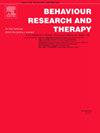What makes a trauma ‘pathological’? – Perceived peritraumatic threat influences the development of intrusive memories
IF 4.2
2区 心理学
Q1 PSYCHOLOGY, CLINICAL
引用次数: 0
Abstract
Intrusions are a hallmark symptom of posttraumatic stress disorder (PTSD). While dysfunctional cognitions are known posttraumatic contributors, peritraumatic processes are less understood. Perceived threat, alongside emotional factors, is theorized as significant, but experimental studies are lacking. Using the trauma film paradigm (TFP), we investigated peritraumatic threat's impact on intrusion development. Healthy participants (N = 93) viewed different distressing film clips (low, medium, high threat). Differences among the experimental groups were examined in the frequency and distress of intrusive memories, as well as distress and expectations. As hypothesized, the frequency of intrusive memories increased with increasing threat load, as did the distress and expectations related to intrusions. Fear elicited by film clips did not mediate this effect. Perceived threat is a crucial peritraumatic factor in intrusive memory formation, suggesting that a trauma perceived as highly threatening increases intrusion likelihood. Understanding traumatic factors influencing posttraumatic symptoms helps in targeting preventive interventions.
是什么让创伤成为“病态的”?-感知创伤周围威胁影响侵入性记忆的发展。
入侵是创伤后应激障碍(PTSD)的标志性症状。虽然功能失调的认知是已知的创伤后因素,但创伤周围的过程却鲜为人知。感知到的威胁和情绪因素一起被认为是重要的,但缺乏实验研究。采用创伤膜范式(TFP)研究了创伤周围威胁对入侵发展的影响。健康的参与者(N = 93)观看了不同的悲伤电影片段(低、中、高威胁)。实验组之间的差异在于侵入性记忆的频率和痛苦程度,以及痛苦程度和期望程度。正如假设的那样,侵入性记忆的频率随着威胁负荷的增加而增加,与入侵相关的痛苦和期望也随之增加。电影片段引发的恐惧并没有调解这种效应。感知到的威胁是侵入性记忆形成的关键创伤周围因素,这表明被认为具有高度威胁的创伤会增加入侵的可能性。了解影响创伤后症状的创伤因素有助于采取针对性的预防性干预措施。
本文章由计算机程序翻译,如有差异,请以英文原文为准。
求助全文
约1分钟内获得全文
求助全文
来源期刊

Behaviour Research and Therapy
PSYCHOLOGY, CLINICAL-
CiteScore
7.50
自引率
7.30%
发文量
148
期刊介绍:
The major focus of Behaviour Research and Therapy is an experimental psychopathology approach to understanding emotional and behavioral disorders and their prevention and treatment, using cognitive, behavioral, and psychophysiological (including neural) methods and models. This includes laboratory-based experimental studies with healthy, at risk and subclinical individuals that inform clinical application as well as studies with clinically severe samples. The following types of submissions are encouraged: theoretical reviews of mechanisms that contribute to psychopathology and that offer new treatment targets; tests of novel, mechanistically focused psychological interventions, especially ones that include theory-driven or experimentally-derived predictors, moderators and mediators; and innovations in dissemination and implementation of evidence-based practices into clinical practice in psychology and associated fields, especially those that target underlying mechanisms or focus on novel approaches to treatment delivery. In addition to traditional psychological disorders, the scope of the journal includes behavioural medicine (e.g., chronic pain). The journal will not consider manuscripts dealing primarily with measurement, psychometric analyses, and personality assessment.
 求助内容:
求助内容: 应助结果提醒方式:
应助结果提醒方式:


